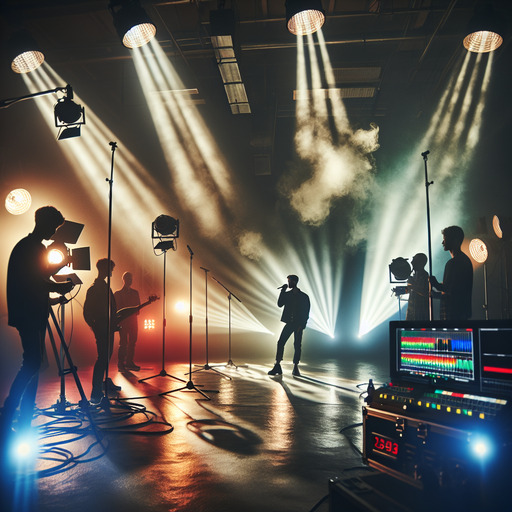
-
Table of Contents
Unlock the secrets to stunning music video production with expert lighting techniques for cinematic results! Elevate your visuals and captivate your audience. Learn more here.
Introduction
Music video production lighting techniques are pivotal in crafting visually compelling and emotionally resonant cinematic results. Effective lighting not only illuminates the scene but also sets the mood, enhances the narrative, and highlights the performance of the artists. Techniques such as three-point lighting, which includes key, fill, and backlighting, help create depth and dimension. Color gels and filters can be used to evoke specific emotions or themes, while dynamic lighting setups, such as moving lights and strobe effects, add energy and excitement. Additionally, practical lighting, which incorporates real-world light sources like lamps or neon signs, can lend authenticity and texture to the visuals. Mastery of these techniques allows directors and cinematographers to transform a simple performance into a visually stunning and memorable music video.
Mastering Music Video Production Lighting Techniques for Cinematic Results
Mastering music video production lighting techniques is essential for achieving cinematic results that captivate audiences and elevate the visual storytelling of a song. Lighting, often considered the backbone of visual aesthetics, plays a crucial role in setting the mood, highlighting key elements, and enhancing the overall narrative. To create a compelling music video, understanding and implementing various lighting techniques is paramount.
One of the foundational aspects of lighting in music video production is the use of three-point lighting. This classic technique involves three primary light sources: the key light, the fill light, and the backlight. The key light is the main source of illumination, typically positioned at an angle to create depth and dimension. The fill light, placed on the opposite side, softens shadows cast by the key light, ensuring that the subject is well-lit without harsh contrasts. The backlight, or rim light, is positioned behind the subject to create a subtle halo effect, which helps to separate the subject from the background and adds a sense of depth.
Transitioning from basic to more advanced techniques, the use of color lighting can significantly impact the mood and tone of a music video. Colored gels or LED lights can be employed to bathe scenes in hues that evoke specific emotions. For instance, blue lighting can create a melancholic or introspective atmosphere, while red lighting can convey passion or intensity. By carefully selecting and blending colors, directors can enhance the emotional resonance of the music and lyrics, creating a more immersive experience for viewers.
Another critical technique is the strategic use of natural light. Shooting during the golden hour, which occurs shortly after sunrise or before sunset, can provide a soft, warm glow that is highly flattering and cinematic. Natural light can be harnessed to create a sense of realism and authenticity, making the visuals feel more organic and relatable. However, it is essential to plan meticulously, as the window for optimal natural lighting is limited and requires precise timing.
In addition to natural light, practical lighting—using light sources that are visible within the scene, such as lamps, candles, or neon signs—can add a layer of realism and enhance the narrative. Practical lights can serve as both functional and aesthetic elements, contributing to the overall ambiance and helping to ground the visuals in a believable setting. When used creatively, practical lighting can also introduce interesting shadows and highlights, adding texture and depth to the composition.
Moreover, the interplay of light and shadow is a powerful tool in music video production. Chiaroscuro, the technique of using strong contrasts between light and dark, can create dramatic and visually striking images. By manipulating shadows, directors can guide the viewer’s attention, emphasize certain aspects of the scene, and convey underlying themes or emotions. This technique is particularly effective in black-and-white music videos, where the absence of color places greater emphasis on light and shadow dynamics.
Finally, the importance of lighting control cannot be overstated. Utilizing tools such as diffusers, reflectors, and flags allows for precise manipulation of light, ensuring that it falls exactly where needed. Diffusers soften harsh light, creating a more even and flattering illumination, while reflectors can bounce light into shadowed areas, providing additional fill. Flags, on the other hand, can block or shape light, offering greater control over the lighting setup.
In conclusion, mastering music video production lighting techniques is a multifaceted endeavor that requires a deep understanding of both technical and artistic principles. By employing a combination of three-point lighting, color lighting, natural and practical light sources, and the strategic use of shadows, directors can achieve cinematic results that enhance the storytelling and emotional impact of the music. Through careful planning and creative execution, lighting can transform a music video into a visually stunning and memorable work of art.
Q&A
1. **Question:** What are some key lighting techniques used in music video production to achieve cinematic results?
**Answer:** Key lighting techniques include:
– **Three-Point Lighting:** Utilizes key light, fill light, and back light to create depth and dimension.
– **High-Key Lighting:** Produces a bright, even illumination with minimal shadows, often used for upbeat or pop music videos.
– **Low-Key Lighting:** Emphasizes shadows and contrast, creating a moody or dramatic effect, suitable for genres like rock or hip-hop.
– **Color Gels and Filters:** Adds color to the lighting to match the mood or theme of the video.
– **Practical Lighting:** Incorporates visible light sources within the scene, such as lamps or neon signs, to enhance realism.
– **Soft Lighting:** Uses diffusers or softboxes to create a gentle, flattering light, often used for close-ups and beauty shots.
– **Hard Lighting:** Produces sharp shadows and high contrast, useful for creating a more intense or edgy look.
– **Silhouetting:** Lights the background while keeping the subject in shadow, creating a dramatic outline.
– **Motivated Lighting:** Ensures that the light sources in the scene appear to come from logical places within the environment, enhancing believability.